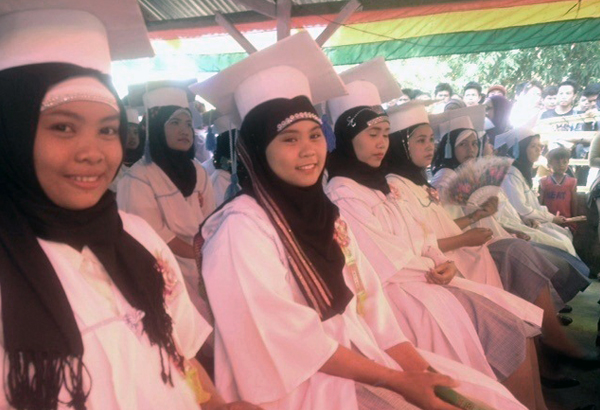MAGUINDANAO, Philippines - Graduating students of the Mamasapano National High School (MNHS) marched on Thursday, uncertain if they can pursue college due to the nagging security problems hounding their villages.
Among the graduates were children of poor farmers in Pidsandawan, Tukanalipao and Inog-og areas in Mamasapano town, scenes of the deadly January 25 encounter between policemen and secessionist rebels, now known as the "Mamasapano incident."
The hostilities, which left 44 Special Action Force commandos, 17 secessionist rebels and five innocent villagers dead, also challenged the now 18-year peace deal between the government and the Moro Islamic Liberation Front.
Families of most of the graduates have been confined in squalid evacuation sites since March 3, forced to abandon their homes by the continuing face-off between the military and the outlawed Bangsamoro Islamic Freedom Fighters (BIFF), which started two days before.
Some of the graduates had told reporters they are reluctant to return to their villages for fear of being tagged by the BIFF as “military collaborators,” after Marine and Army units took over at least five guerilla lairs in Mamasapano and nearby towns in tactical maneuvers in the past three weeks.
Thursday’s graduation rite at the MNHS was jointly facilitated by the Army’s 6th Infantry Division and its component-unit, the 601st Brigade, and the Department of Education in the Autonomous Region in Muslim Mindanao.
Col. Melquiades Feliciano, commanding officer of the 601st Brigade, keynote speaker in the event, said military operations against the BIFF had been temporarily suspended to pave the way for graduation rites for elementary pupils and high school students in Mamasapano and neighboring towns.
“The military values education as something so essential in the propagation of peace and development in Moro communities,” Feliciano said.
The venue of the graduation program Feliciano helped officiate was tightly guarded by combatants of the 601st Brigade and members of a mechanized battalion based in Sharif Aguak, the former provincial capital, about seven kilometers away.
The BIFF, led by radical jihadists, many of them graduates of secular religious schools in the Middle East and North Africa, is feared for its enforcement of a ruthless Taliban-style justice system in areas where it operates.
The extremist group has also been discouraging Moro parents from sending their children to regular schools on the pretext they could veer away from Islamic way of life.
The valedictorian of MNHS, Bai Sakina Masukat, had told reporters she would pursue college education at all cost so she could help their municipality as an employed professional.
More than 60 percent of residents in Mamasapano were forced to relocate to evacuation centers for fear of getting trapped in the crossfire between the BIFF and the pursing Marine and Army combatants.
There are now 123,612 evacuees in dozens of relief sites in Mamasapano and six nearby towns in the second district of Maguindanao, surviving on food and water rations from the ARMM’s Humanitarian Emergency Assistance and Response Team (HEART) and the emergency and disaster mitigation contingent of the office of Gov. Esmael Mangudadatu.
ARMM Gov. Mujiv Hataman, chairman of the inter-agency regional peace and order council, said one of their concerns now is how to ensure the re-opening of public schools in conflict-stricken towns in June.
“In the meantime we have to attend to the needs of the evacuees in relief sites,” said Hataman, who is overseeing the operations of the HEART.
The ARMM government is spending P12.3 million weekly for the food of the evacuees.


